Features
Emotions, learning, and democracy: Reviving the spirit of education
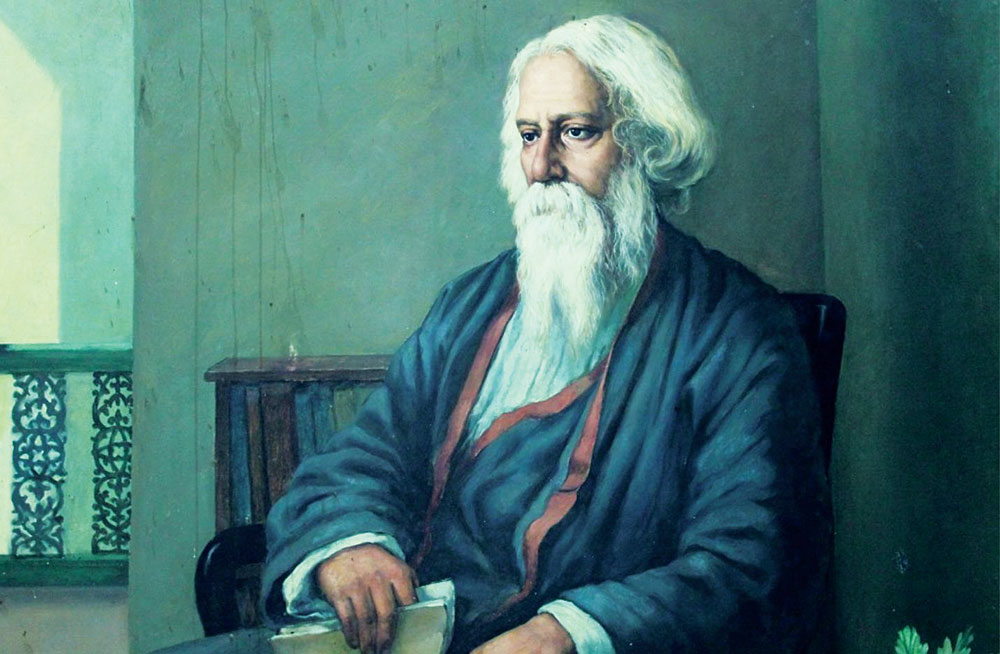
When a father becomes a gambler and his obligation to his family takes the secondary place in his mind, he is no longer a man, but an automaton led by the power of greed.
(Tagore, Nationalism, 2018)
(Excerpts of the keynote address at Annual Sessions at the Faculty of Education, The Open University of Sri Lanka––Empowering Minds: Education for New Era.)
As I am coming from the Humanities and Social Sciences and Performance Studies disciplines, I have a close affinity with education and education philosophy. I have also been engaged in the current debate on higher education, writing and presenting my ideas with the academia and the public domains. I have been motivated by the like-minded scholars (Senanayake, 2021; Amarakeerthi, 2013; Uyangoda, 2017 & 2023; Rambukwella, 2024; Jayasinghe & Fernando 2023; & Jayasinghe 2024) who have been continually discussing problems related to our education and the role of humanities and aesthetics within this sphere. Some of the recurrent themes I have raised in these writings are burning issues in our current education scenario.
Among them, the indoctrination, decline of the arts and aesthetic education in our education sector, and the importance of creative arts in human development were prominent. Hence, in today’s speech, I will continue this discussion and try to broaden the scope of it. The theme of today’s speech can be categorized in three areas of studies: emotions, education, and democracy. What I am going to present today is the role of emotion in education and how this new paradigm of education could lead to the democratic establishments in society. In this speech, I try to build a connection between these key areas of arts and aesthetic education, its vital ingredient of empathy, and how this empathic education supports democracy in the society. This argument will be further elaborated in the course of my talk.
We, as a nation, are on the verge of a transition. This transition has been gradually taking place in our society through the influences of neo liberal economic and political changes happening throughout the region. The glory of our free education system and the heritage we envisioned have also been challenged by the new developments of private educational institutions. These new trends have distorted the true meanings while diminishing the philosophical and moral values of education.
It is the skill acquisition that has come to the fore of the educational discourse. Skills that can be used in the social milieu, and can support the economic growth of the country have been commissioned for our curricula. This mantra has been circulated and supported by the governments which ruled this country for decades. We, as academics, have also adopted strategies to cater these policies to indoctrinate our children to become future entrepreneurs. All the philosophical and moral values of education have been reduced to produce mere labourers. Education is interpreted as a commodity, which is being sold in the market based on supply and demand. We are advised that if we cannot compete in the market, our survival is at stake.
Now, who are we? And, where are we? Where is our society heading? These simple but vital questions are important for us to rethink how we educate our children and what we gain out of it. What kind of society we have created today, as a whole after implementing those educational policies imposed by the authorities? Over the past few years, the world has gone through a myriad obstacles and difficulties facing a worldwide pandemic and devastating wars. After many centuries, we faced the Covid-19 pandemic which challenged us on how we live as a community. Over two years, we were locked down and were isolated from the world. We were locked down in our own houses and the social distancing was imposed reframing ourselves to be connected with each other.
Pandemic, Aragalaya and emotions
Pandemic introduced different ways of learning and teaching in our education sector. The traditional ways of teaching and learning were replaced by the online modes of learning. We started conducting seminars and lectures through online zoom technology and other modes to connect with our students. Students, somehow or other, connected with us through their mobile phones and other devices. The conception behind all these technological advancements implied that the education can be successfully delivered via online mode, and the cost can also be reduced drastically allowing the government to reduce the cost of education and infrastructure.
However, the vital concepts in the educational business, such as corporeality, subjectivity, intersubjectivity, temporality, and spatiality have been redefined and challenged. The learning and teaching were redefined in the virtual reality, reducing the values of interpersonal and corporeal connections between learners. We tend to believe that it is not important for the learner to be present in front of other learners but is enough for her or his virtual avatar to be present.
Soon after the taming of the pandemic situation, our society was shattered with the economic bankruptcy and social upheavals. The financial hardship experienced by the people of the country, resulted in demand for basic needs, cooking gas, petrol, and other important rations. Vigil and silent protests, followed by the mass movements and occupation, ignited the country’s largest non-party people’s struggle, Aragalaya.
Youth of the country encamped the Galle Face Green, and established alternative communal spaces. Cinema, school, community kitchen and even an alternative people’s university were established. Within a few days, many GotaGoGama encampments were established in major cities of the country demanding the President and the Parliament to resign. The new people’s democracy was established by people, for people. This mass movement not only showed us new ways of governing the country but also new ways of living as a community. Human connection and communal living were established until the military actions uprooted the GotaGoGama encampment.
You must be wondering why I am trying to recall this unpleasant past of our social memory. Why is it important for us to go back and see how we passed this phase of time and have come to this point today? As my key ideas are related to emotional education, empathy, arts, and democracy, it is important for us to revisit such a brutal past and learn lessons from it. The pandemic situation taught us how it is important for us, as human beings, to be connected and live with each other as a society.
The pandemic taught us the importance of revisiting communal life, which has sustained and enriched our lives for centuries. Aragalaya further emphasised the importance of communal struggle and co-living in order for us to establish a democratic society. Democracy cannot be sustained without human engagement. It is not something that the ruling government or an alien authority donates to us. It is something that is generated through human connections and collective will. If we clearly scrutinise those two phenomena we experienced in the recent past, it is evident that in the first phenomenon, the pandemic challenged our emotional engagement with others. In the second phenomenon, Aragalaya, we witnessed how important emotions are to reconnect with people and demand for democracy.
Anxiety of our time
Today, as educators, we are on the verge of resolving complex issues related to education. Information technology and AI have invaded the traditional teaching and leaning approaches. The role of the teacher is being challenged and also being shifted by artificial intelligence. The question arises, whether we have a key role to play in the lecture theatre or in the classroom when AI invades our positions. With technological advancement and artificial intelligence, our role as teachers and also what we teach are being challenged. Now, the question is what educational philosophy or theory is suitable for us to guide our next generation of learners’ what methods are appropriate for this new generation to learn and become valuable citizens for the country.
The argument that I want to bring forward is that in our education, we lost the key ingredient, which is the affective development in learning. In other words, we have not focused on how our learners should be equipped with emotional educational principles. Affective components of our education were marginalised or forgotten in favour of promoting skill development or manual learning. One of the reasons behind this lack is the way we conceptualised our educational policies, defining education in dichotomous ways.
For instance, as philosopher john Dewey says, ‘theory and practice, individual and group, public and private, method and subject matter, mind and behaviour, means and ends, and culture and vocation’ (Palmer et al., 2002, p. 197) are the ways that we defined our educational principles. Dewey’s educational philosophy is based on the key principle that the children should learn in the classroom where they learn the society through ‘miniature community and or embryonic society’ (Palmer et al., 2002, p. 196). It is vital for the students to learn this communal living, because in the larger canvas, they learn to live in the democratic society as elders. Communal empathy is thus a vital component in developing a healthy, democratic and caring society where each person has a place and respect.
Today, we focus on education, but the truth is we are living in a paradoxical era. Bruzzone (2024) argues that with this pandemic situation, the ongoing conflict between developed nations, and also the advancement of television and online technology, our young generation is in a conundrum. Living in these complex social terrains, our young generation is experiencing complex inner upheavals. He argues that,
The rhetoric of happiness and the entertainment industry keep children and adolescents in a state of intermittent distraction that prevents them from exploring their inner self, including its less appealing, grey areas. Cinema, TV, and video games elicit strong emotions, helping the young to evade the desert of boredom and apathy (Bruzzone, 2024, p.2).
Even though our young people are equipped with devices throughout their livelihood, more or less they are isolated. The media always exaggerates that with mobile technology and other online devices, we are connected to the world and are not isolated.
We also tend to think that we are a part of global citizenship. However, the truth is that most of us are becoming isolated though we are connected with others through technology. Hence, Bruzzone argues that in order to overcome such isolation, existential vacuum and indifference, people tend to experience adrenaline rushes through various risk behaviours, speeding, loud music, and psychotropic substances (Bruzzone, 2024).
Affective life
What I argue here is not to give up our engagements with the new technology or devices but to find ways of reawakening our emotional life within us. This affective life is still hidden in our life that our learners do not know how to find it; or rather, we have not taught them to unlock this emotional life within. Our education, as I argued earlier, does not have such intention or components where the learners can be equipped with emotional intelligence.
We have thrown away all the important aspects of such components in our educational system in favour of developing manual learners. These manual learners do not have such empathic life, affection, or emotional intelligence to deal with their own emotional lives, or they do not have knowledge to deal with others in the society. The result is what we have today: the merciless society where people are competing with each other to accumulate material wealth. Citing Galimberti (2007), Bruzzone further argues how this can create a societal issue when the individual cannot cope with his/her emotional life:
This inability to express and share emotions can sometimes explode, taking the form of uncontrolled aggression and impulsive and maladaptive ways of acting out: when this occurs, unacknowledged emotional experiences (of anger, frustration, a sense of inadequacy, fear, and so on) turn into words or acts of hatred and violence—usually towards vulnerable individuals–,flagging a growing dis-connect between acting, reasoning, and feeling: the heart is not in tune with thought nor thought with action (Bruzzone, 2024, p. 2).
Thus, our education has created this person who is struggling to connect with the heart; heart with the thought and thought with action. This dislocation of the heart with thought and action has resulted in developing antipathy towards the society. This antipathy also destabilizes the democratic social value systems. If we really need to re-establish a democratic society, we should first focus on our existing education system.
It is not all about how we integrate new technology and equipment to facilitate our learners but it is about how we allow our learners to first unlock their emotional life, and secondly think how they reconnect with the society. A new educational approach should be tailored to facilitate this vital objective. Hence, let me briefly discuss how creative arts and aesthetics can be useful for developing such individuals who will be empathic as well as critical towards the social changes taking place in this millennium.
At this juncture, it is important to revisit one of the key thinkers and an educational philosopher, Rabindranath Tagore. Tagore is one of the few philosophers who have been thinking and developing an alternative learning approach through his Vishva Bharathi concept. He established Shanti Niketan where this new approach was primarily being tested. Encapsulating his philosophy of learning, he argued,
For us, the highest purpose of this world is not merely living in it, knowing it and making use of it, but realizing ourselves through expansion of sympathy and not dominating it, but comprehending and uniting it with ourselves in perfect union (Bhattacharya, 2014, p. 60).
As this statement clearly indicates, Tagore’s vision of education is developed for cultivating sympathy towards other humans and the environment alike. This education does not persuade the learner to think about his/her environment as something that can be commodified and utilized as material. The environment where the individual is living is also a living entity that is intertwined with human beings. Therefore, the individual should think in a different way to converge with the environment and find a place for co-living. In order to establish such an empathic educational approach, we need a different mode of educating young people. This Tagorean approach to education clearly emphasizes the value of the affective nature of education. It is the emotional life of the individual which is focused and cultivated through various means of teaching and learning.
Emotion and democracy
As of today, we lack this vital emotional component in our education. One of the fallacies behind this situation is that we tend to believe that emotions reside within ourselves, and they are private and personal. This is a misconception that is being sustained through our existing systems of education. However, on the contrary, emotions do not only provide richness to our own personal lives but they are also the primal tool that connects us with the outer world. In other words, we connect with other human beings in the society through our emotional arc. If the individual disconnects the communal engagement, this can result in destructive mannerism.
‘This disintegration of reciprocity, which weakens the social fabric, effectively leaves the individual isolated in a state of loneliness and uncertainty’ (Bruzzone, 2024, p. 13). This isolation and uncertainties of individuals can also have a negative impact on the healthy relationship with communities and, largely, on the democratic institutions. As scholars argue, this can be resulted in sustaining endogamous, xenophobic and violent neo-tribal grouping that have mushroomed in our society. This is what we have seen in the form of various nationalist upheavals in our society for the last few decades.
This tendency, therefore, leads us to further think about the value of emotional education and also its role in communal living. Further, emotions and emotional competency lead us to engage with other subjects, and also emphasizes that it is a bridge that is built between you and me and the world. When this bridge is broken, our connections between myself, you, and the world could be destabilized and shattered.
That is why scholars such as Bruzzone argue that ‘affectivity is also an ethical and political issue’ (Bruzzone, 2024, p. 12). It is ethical in the sense that my engagement or disengagement with the social beings are formed and developed through the emotional desires that I have inherited. Further, it is political, because, when the individual assumes that his/her existence relies on the communal existence, this assumption leads to political action of individuals. Hence, emotional education is vital for the healthy existence of a society. Cusinato, therefore, states that ‘emotional education is at the core of democracy’ (Cusinato Cited by Bruzzone, 2024, p, 13).
Finally, I would like to highlight one of the brilliant minds of our time, Prof Martha C. Nussbaum and her ideas on why arts education is vital for a continuation of democracy, and also how emotional education is important to achieve this (Helsinki Collegium, 2024). Today, as a civilization, we are confronting various and complex issues threatening the continuation of the human race. These key issues are not limited to countries or nations. They are applicable to all human beings currently living in the world.
Environmental crisis, global warming, food security, poverty, and war are some of the recurrent issues we face today. In order to focus on these larger humanitarian crises, how could we equip our students to think in broader ways to tackle these complex issues? Nussbaum provides us some important points to think on how we could design our education system where the individual can be more empathetic and passionately engage with worldly phenomena. According to her, we need citizens who have the capacity to think and see the world as other people see the world; need to develop the capacity for genuine concern of others, near and distant; teach real things about other groups in the society and learn to reject stereotypes; and promote accountability and critical thinking, ‘the skill and courage it requires to raise a dissenting voice’ (Nussbaum, 2016, p. 45-46).
Conclusion
Nussbaum’s recent works largely focus on how human emotions are connected to the establishment of democratic societies in the world. Arts, culture, and humanities play significant role in promoting positive emotions amongst participants. It also promotes wellbeing and happiness which are vital for a healthy society. Today, we have a new government. This government often emphasizes the importance of investing in education, from primary levels to higher education. They have shown the commitment to change the existing stale education systems which need drastic and constructive criticisms to change for a better system. Thus, we, as educators, thoroughly believe that it is time for us to revisit what we have taught and how we have taught our younger generation for decades. It is time for us to rethink new ways of tailoring our education system where we could promote empathy and develop empathetic citizens who care about others and the environment we live in.
Thank you.
References
Bhattacharya, Kumkum. 2014. Rabindranath Tagore: Adventure of Ideas and Innovative Practices in Education. Cham: Springer International Publishing.
Bruzzone, Daniele. 2024. Emotional Life: Phenomenology, Education and Care. Springer Nature.
Harshana Rambukwella. 2024. “The Cultural Life of Democracy: Notes on Popular Sovereignty, Culture and Arts in Sri Lanka’s Aragalaya.” South Asian Review, July, 1–16.https://doi.org/10.1080/02759527.2024.2380179 .
Helsinki Collegium. 2024. “Democracy and Emotions– a Dialogue with Philosopher Martha C. Nussbaum.” YouTube. June 6, 2024. https://www.youtube.com/watch?v=p3xdcfbE3KA.
Jayasinghe, Saroj. 2024. “Arts and Humanities in Medical Education: Current and Future.” Jaffna Medical Journal 36 (1): 3–6. https://doi.org/10.4038/jmj.v36i1.202.
Jayasinghe, Saroj, and Santhushya Fernando. 2023. “Developments in Medical Humanities in Sri Lanka: A Call for Regional and Global Action.” The Asia Pacific Scholar 8 (4): 1–4.https://doi.org/10.29060/taps.2023-8-4/gp2878.
Karunanayake, Panduka. 2021. Ruptures in Sri Lanka’s Education: Genesis, Present Status and Reflections. Nugegoda: Sarasavi Publishers.
Nussbaum, Martha C. 2016. Not for Profit Why Democracy Needs the Humanities. Princeton University Press.
Palmer, Joy, David Cooper, and Liora Bresler, eds. 2002. Fifty Major Thinkers on Education. Routledge.
Uyangoda, Jayadeva, ed. 2023. Democracy and Democratisation in Sri Lanka: Paths, Trends and Imaginations. 1st ed. Vol. 1 and 2. Colombo: Bandaranaike Centre for International Studies.
Short bio of the speaker
Saumya Liyanage (PhD) is an actor both in theatre and film and also working as a professor in Drama and Theatre at the Department of Theatre Ballet and Modern Dance, Faculty of Dance and Drama, University of the Visual and Performing Arts (UVPA), Colombo, Sri Lanka. Professor Liyanage was the former Dean of the Faculty of Graduate Studies, UVPA Colombo and currently holds the position of the Director of the Social Reconciliation Centre, UVPA Colombo.
Acknowledgements
The author wishes to thank Himansi Dehigama for proofreading the final manuscript of this keynote speech.
This keynote is delivered at the annual sessions of the Faculty of Education, Open University of Sri Lanka on the 6th of February 2025.
by Professor Saumya Liyanage
(BA Kelaniya, MCA Flinders, Australia, PhD La Trobe, Australia)
Department of Theatre Ballet and Modern Dance
Faculty of Dance and Drama
University of Visual and Performing Arts, Colombo, Sri Lanka
Features
Evolution of Paediatric Medicine in Sri Lanka: Honouring Professor Herbert Aponso on his 100th Birthday.
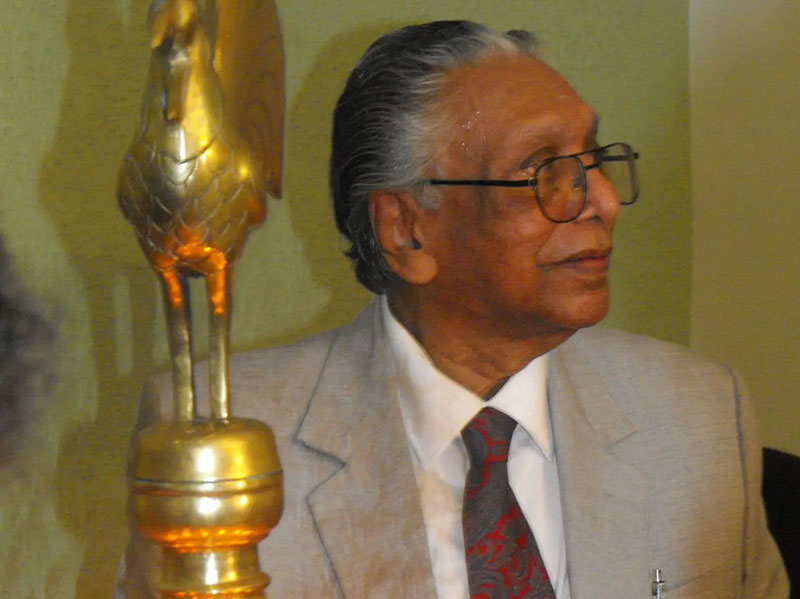
Professor Herbert Allan Aponso, born on March 25, 1925, recently celebrated his 100th birthday at his serene home in Kandy. Surrounded by his cherished children, the occasion not only honoured his extraordinary life but also served as a tribute from his academic colleagues, recognising his outstanding contributions to the field of paediatrics in Sri Lanka. Professor Aponso is widely recognised for his exceptional ability to combine extensive field experience with academic teaching and groundbreaking research. He emphasised social causes of disease and maintained that a disease is not just a manifestation of biological factors in the human body, but an expression of social and environmental factors as well. He encouraged his students to consider social aspects, such as family factors and poverty, in order to explain diseases, particularly childhood diseases such as malnutrition.
Born in Lakshapathiya, Moratuwa, Aponso began his academic journey at Prince of Wales College, Moratuwa, excelling in the Senior School Certificate and London Matriculation Examinations. His medical aspirations led him to the University of Colombo in 1943 and subsequently to the Medical College, where he graduated MBBS with honours in 1949. Pursuing further specialisation, he trained in paediatrics at the prestigious Great Ormond Street Hospital for Children, the largest and oldest children’s hospital in the UK, earning his DCH (London) in 1956 and MRCP (Edinburgh) in 1957.
Upon his return to Ceylon in 1958, Aponso earned his MD in Medicine and commenced a distinguished academic career. He joined the Faculty of Medicine in Colombo as a Senior Lecturer in 1963 and subsequently took on the role of Lecturer-in-Charge of Paediatrics at the University of Ceylon in Peradeniya in 1964. His career saw steady progression as he was promoted to Associate Professor in 1974 and ultimately attained the position of full Professor of Paediatrics in 1977.
Aponso was a Fellow of both the Royal College of Physicians (Edinburgh) and the Ceylon College of Physicians. He actively contributed to the Kandy Society of Medicine, where he served as President from 1974 to 1975. Beyond medicine, he played key roles in community organisations. Before relocating to Kandy, he was the president of the Moratuwa YMCA and a founding member of the Moratuwa Y’s Men Club. Later, he led the Kandy Y’s Men’s Club, which evolved into the Mahanuwara Y’s Men’s Club.
His contributions extended into promoting nutritional advancements, notably advocating for the consumption of soya. He pioneered the preparation of soya products in the kitchen of the Peradeniya Teaching Hospital and established a Soya Centre linked to the Kandy YMCA. Further showcasing his dedication to public health, he presided over the Sri Lanka Association for Voluntary Surgical Contraception and Family Health during two separate periods: 1977–1979 and 1986–1987. Additionally, he led the Sri Lanka Paediatric Association from 1976–1977.
Even after retiring from the University of Peradeniya in 1993, his impact endured. In recognition of his lifelong contributions, the university awarded him an honorary DSc in 2022. Through his tireless dedication, Professor Aponso profoundly influenced paediatric medicine in Sri Lanka, leaving an enduring legacy in both academic and medical spheres. Paediatrics as a specialised field of medicine in Sri Lanka has evolved over centuries, shaped by indigenous healing traditions, colonial medical advancements, and modern institutional developments. During colonial times under the Portuguese and Dutch, children continued to be treated through traditional medicine. The British colonial administration formalised Western medical education and established hospitals. In 1870, the Ceylon Medical College (now the Faculty of Medicine, University of Colombo) was founded, producing doctors trained in Western medicine. Paediatric care as a distinct discipline began to emerge in the early 20th century, having previously been part of general medicine. The introduction of vaccination programmes, particularly against smallpox, was a major public health advance introduced under the Vaccination Ordinance of 1886. It was during the1920s that Maternal and Child Health Clinics were setup in villages, laying the foundations for addressing child health issues in the country.
The early decades of the century saw the establishment of paediatric units in major hospitals, a critical step towards recognising and addressing the distinct medical needs of children. The establishment of paediatric units in major hospitals in Sri Lanka began in the mid-20th century, with significant developments occurring in the 1950s and 1960s. These units were set up to provide specialised care for children, addressing their unique medical needs. For example, the Lady Ridgeway Hospital for Children in Colombo became a national tertiary care centre, offering advanced paediatric services Hospitals such as the Colombo General Hospital (now the National Hospital of Sri Lanka) and played a pioneering role in creating specialised wards dedicated to paediatric care, laying the foundations for future advancements in the field.
A major turning point in the progress of paediatrics in Sri Lanka came with the appointment of Dr. C. C. de Silva as the first Professor of Paediatrics at the University of Ceylon (now the University of Colombo) in the 1950s. He was instrumental in formalising paediatric education and training, ensuring that future medical professionals were equipped with the knowledge and skills to provide specialised care for children. The introduction of dedicated paediatric courses in medical schools marked a shift from traditional general practice to a more specialised approach to child healthcare. The 1950s also saw the expansion of paediatric services beyond Colombo, with provincial hospitals establishing their own paediatric units, making specialised care accessible to a wider population.
The latter half of the 20th century witnessed remarkable progress in paediatric care, with the establishment of postgraduate training programmes aimed at producing highly qualified paediatricians. These programmes were designed to meet the increasing demand for specialised medical professionals who could address the complex healthcare needs of children. Alongside these educational advancements, there was a significant improvement in neonatal and maternal healthcare services, leading to better survival rates for newborns and reducing infant mortality. Innovations in paediatric research and healthcare policies further contributed to improvements in the overall well-being of children in Sri Lanka.
By the 1980s, paediatrics had firmly established itself as a distinct and essential medical discipline in Sri Lanka. The introduction of specialised paediatric subfields such as neonatology, cardiology, and nephrology allowed for more targeted treatment and improved health outcomes for children with complex medical conditions. The role of paediatricians expanded beyond hospital care, with increased involvement in public health initiatives such as immunisation programmes and nutritional interventions. The collaborative efforts of the government, medical institutions, and healthcare professionals ensured that paediatric care in Sri Lanka continued to progress in parallel with global medical advancements.
The development of paediatric specialization in Sri Lanka during the 20th century was a transformative journey that laid the groundwork for the country’s modern child healthcare system. From its humble beginnings in general hospital wards to the establishment of specialised training programmes and research initiatives, paediatrics evolved into a well-defined and essential medical discipline. This progress not only improved healthcare outcomes for children but also contributed to the overall strengthening of the medical field in Sri Lanka. Today, paediatrics continues to be a vital component of the healthcare system, building upon the foundations set during the 20th century to ensure a healthier future for the nation’s children. Professor Aponso was integral to the shaping of this process of development, in the 1950s and afterwards, fully engaged in every aspect. His involvement was not just academic, as he was an advisor to the government and other organisations, such as the World Health Organization, on matters about advancements in child health.
One of his most significant accomplishments was a six-year research project, generously funded by the World Health Organization (WHO) and the Canadian International Development Agency (CIDA). This initiative was integral to addressing pressing health challenges within the Mahaweli Accelerated Development Programme in its initial phase. The project focused particularly on improving healthcare services in System ‘C’ of Girandurukotte, a region populated by settlers relocated from villages inundated due to the construction of large tanks and reservoirs. The programme was launched shortly after the settlers arrived, aiming to tackle the myriad health issues they encountered as newcomers to the dry zone settlements.
Under Aponso’s leadership, ‘mothers’ clubs’ were established in hamlets in each of the four settlement units chosen for intervention. These clubs became vital community spaces where families could engage in discussions about the health problems they faced. The challenges were numerous and varied, including skin diseases, issues with drinking water, snake bites, elephant attacks, and accidents sustained while working in newly cleared paddy lands. Malaria and flu posed an especially serious threat at the time, necessitating timely treatment.
The mothers’ clubs operated as dynamic forums where settlers could participate in question-and-answer sessions about their health concerns. These sessions often culminated in providing treatments for those afflicted. The efforts were supported by Dr. (Mrs.) Fernando, a dedicated health officer in ‘System C’ of Girandurukotte, who attended most of the meetings, ensuring professional medical assistance. Professor Aponso was also assisted by lecturers at the Department of Paediatrics and a health education officer, Mrs. Alagoda, whose skills in engaging with mothers played a pivotal role in the success of the discussions and outreach programmes.
During this period, the Centre for Intersectoral Community Health Studies (CICHS) emerged under the visionary leadership of Professor Aponso. As an interdisciplinary scholarly organisation dedicated to advancing health research in Sri Lanka, CICHS made remarkable strides in the field. Among its pioneering initiatives, the sexual-risk prevention programme stood out as a milestone. This programme prioritised fostering individual competencies while shaping cultural norms that encourage healthy sexual decision-making, reflecting the organisation’s commitment to impactful research and community well-being.
As the project manager of the WHO/CIDA project, I had the privilege of working closely with Professor Aponso. I travelled frequently from my office at the Department of Paediatrics at Peradeniya to the villages, coordinating the programme’s activities. We collected household data on a sample within selected settlement units, such as Teldeniyaya, Hombariyawa, Millaththewa and Rambewa. To make a comparison, we also collected data from Mawanella rural villages, which was considered the control area. This information was then meticulously analysed using an IBM computer, a remarkable technological feat at a time when computers were a rarity.
Our research team, comprising approximately ten recent sociology graduates, including KMHB Kulasekera, RM Karunasekara and Nandani de Silva, worked tirelessly to collect, compile and interpret the data. The findings were shared at various conferences in the form of scholarly articles, providing valuable contributions to both national and global conversations on the public health challenges faced by communities in transition.
Professor Aponso’s work not only made a profound impact on the lives of those settlers but also left an indelible mark on the field of social paediatrics, demonstrating the transformative power of community-based health initiatives supported by collaborative research.
Aponso’s contributions to child healthcare, particularly in the areas of neonatology, nutrition, and medical education are important. As a student of Dr. C. C. de Silva, he was deeply influenced by his mentor’s pioneering work in paediatrics and carried forward his legacy by further strengthening child healthcare services in Sri Lanka. Dr. L.O. Abeyratne was the first Professor of Paediatrics at Peradeniya, and, upon his retirement, Professor Aponso succeeded him, continuing to advance paediatric education and healthcare in Sri Lanka. Aponso was particularly known for his work in neonatal care and the prevention of childhood malnutrition. He played a key role in introducing and promoting best practice in newborn care, helping to reduce infant mortality rates in Sri Lanka. His advocacy for improved maternal and child health policies contributed to the expansion of paediatric services beyond Colombo, ensuring that specialized care was accessible to children in rural areas as well.
Beyond clinical practice, Professor Aponso was a dedicated medical educator. He trained and mentored numerous paediatricians, helping to shape the next generation of child healthcare professionals in Sri Lanka. His work in medical research and teaching influenced advancements in paediatric care and was
instrumental in establishing higher standards in paediatric training programmes. In 2011, in commemoration of his work, Dr. Ananda Jayasinghe edited a collection of essays titled ‘In honour of Herbert Allan Aponso, emeritus professor of paediatrics, University of Peradeniya, Sri Lanka.’
Professor Aponso is a remarkable individual whose humility is as profound as his ability to listen with intention and honour to the perspectives of those around him. A celebrated expert in his field, he was elected President of the Sri Lanka Paediatric Association in 1976 and ascended to the role of full Professor of Paediatrics in 1977. His dedication extended far beyond academia—he served as President of the Young Men’s Christian Association in Kandy during three pivotal periods: 1966–1968, 1973–1975, and 1984–1988.
In 1952, he embarked on a lifelong partnership with Jayanthi Vimala Dias, now deceased, building not just a family but a legacy of intellect and social impact. Together, they raised three children—Ajith, Heshan, and Charmalie—who each distinguished themselves in society. Their home became a vibrant epicentre of stimulating dialogue and collaborative ideas, welcoming friends to partake in lively, thought-provoking discussions.
For me, the memory of Professor Aponso is forever intertwined with the dynamic days of the Mahaweli research project and CICHS initiatives, where his presence enriched every endeavour. As he continues his retirement journey, I wish him abundant health and days brimming with vitality, joy, and a renewed sense of purpose.
by M. W. Amarasiri de Silva
(Emeritus Professor of Sociology, University of Peradeniya Sri Lanka and Lecturer at the University of California, Santa Cruz, USA).
Features
Indian colonialism in Sri Lanka

Following independence from Britain, both India and Sri Lanka emerged as leaders of the Non-Aligned Movement, which sought to advance developing nations’ interests during the Cold War. Indeed, the term “non-alignment” was itself coined by Indian Prime Minister Jawaharlal Nehru during his 1954 speech in Colombo. The five principles of the Non-Aligned Movement are: “mutual respect for each other’s territorial integrity and sovereignty; mutual non-aggression; mutual non-interference in domestic affairs; equality and mutual benefit; and peaceful co-existence.”
Later, Indian Prime Minister Indira Gandhi played a key role in supporting Sri Lankan Prime Minister Sirimavo Bandaranaike’s 1971 proposal to declare the Indian Ocean a Zone of Peace at the United Nations.
Such progressive ideals are in stark contrast to the current neocolonial negotiations between the two countries.
Indian Prime Minister Narendra Modi’s forthcoming visit to Sri Lanka on April 4, 2025, is presented as representing a mutually beneficial partnership that will bring economic development to debt-burdened Sri Lanka. However, the details of the strategic agreements to be signed during Modi’s visit remain undisclosed to the public. This opacity cannot be a good sign and should not be accepted uncritically by the media or the people of either nation.
The Indo-Lanka Agreement of July 29, 1987, was also crafted without consultation with the Sri Lankan people or its parliament. It was signed during a 48-hour curfew when former Indian Prime Minister Rajiv Gandhi arrived in Sri Lanka. This agreement led to the imposition of the 13th Amendment to the Sri Lankan Constitution and established the Provincial Council system. The political framework it created continues to challenge Sri Lanka’s territorial integrity and sovereignty. Rather than bringing peace, India’s 1987 intervention resulted in one of the most violent and chaotic periods in the island’s recent history.
Will these agreements being finalised with Prime Minister Modi also lead to a period of pillage and plunder of the island’s resources and worsening conditions for its people, rather than delivering the promised economic benefits? It is crucial that any bilateral agreements include enforceable measures to stop Indian bottom trawlers from illegally fishing in Sri Lankan territorial waters. This decades-long practice has caused severe damage to Sri Lanka’s marine resources and inflicted significant economic losses on its fishing communities.
Facing an increasing Chinese presence in Sri Lanka and the Indian Ocean, India has sought to strengthen its political, economic, strategic and cultural influence over Sri Lanka through various overt and covert means. During Sri Lanka’s 2022 economic crisis, for example, India provided $4 billion in financial assistance through currency swaps, credit lines, and loan deferrals that enabled Sri Lanka to import essential goods from India. While this aid has helped Sri Lanka, it has also served India’s interests by countering China’s influence and protecting Indian business in Sri Lanka.
Prime Minister Modi’s upcoming visit represents the culmination of years of Indian initiatives in Sri Lanka spanning maritime security, aviation, energy, power generation, trade, finance, and cultural exchanges. For example, India’s Unified Payment Interface (UPI) for digital payments was introduced in Sri Lanka in February 2024, and in October 2023 India provided funds to develop a digital national identity card for Sri Lanka raising concerns about India’s access to Sri Lanka’s national biometric identification data. Indian investors have been given preferential access in the privatisation of Sri Lanka’s state-owned enterprises (SOEs) in key sectors like telecommunications, financial services, and energy. Adani Group’s West Terminal project in Colombo Port is explicitly designed to counter China’s control over Sri Lanka’s port infrastructure, including the Colombo International Container Terminal, Hambantota Port, and Port City Colombo.
India and Sri Lanka have recently agreed to resume negotiations on the Economic and Technology Cooperation Agreement (ETCA), which focuses primarily on the service sector and aims to create a unified labour market. However, Sri Lankan professional associations have raised concerns that ETCA could give unemployed and lower-paid Indian workers a competitive advantage over their Sri Lankan counterparts. These concerns must be properly addressed before any agreement is finalised.
On December 16, 2024, India and Sri Lanka signed several Memoranda of Understanding (MOUs) in New Delhi to enhance cooperation in defense, energy, and infrastructure development. These include plans for electricity grid interconnection and a multi-product petroleum pipeline between the two countries. Building on these agreements, construction of the Sampur power plant in Trincomalee is expected to begin during Prime Minister Modi’s April visit.
The Sampur power plant project, combined with India’s takeover of the Trincomalee Oil Tank Farm, represents a significant step toward integrating Sri Lanka into India’s national energy grid. This development effectively brings Trincomalee’s strategic natural harbour – often called the “crown jewel” of Sri Lanka’s assets – under Indian control, transforming it into a regional energy hub. In 1987, during India’s military intervention in Sri Lanka, New Delhi pressured Colombo into signing a secret agreement stipulating that the British-era Trincomalee oil tank farm would be jointly developed with India and could not be used by any other country.
While India promotes its energy interconnection projects as enhancing regional energy security, recent experiences in Nepal demonstrate how electricity grid integration with India has made Nepal dependent on and subordinate to India for its basic energy needs. Similarly, Bangladesh’s electricity agreement with the Adani Group has created an imbalanced situation favouring Adani over Bangladeshi power consumers. What collective actions could Sri Lanka and other small nations take to avoid such unequal “energy colonialism” and protect their national security and sovereignty?
India’s emergence as a superpower and its expansionist policies are gradually transforming neighbouring South Asian and Indian Ocean states into economically and politically subordinate entities. Both Sri Lanka and the Maldives have adopted “India First” foreign policies in recent years, with the Maldives abandoning its “India Out” campaign in October 2024 in exchange for Indian economic assistance.
India’s “Neighbourhood First Policy” has led to deep involvement in the internal affairs of neighbouring countries including Sri Lanka. This involvement often takes the form of manipulating political parties, exploiting ethnic and religious divisions, and engineering political instability and regime changes – tactics reminiscent of colonial practices. It is well documented that India provided training to the LTTE and other terrorist groups opposing the Sri Lankan government during the civil war.
Contemporary Indian expansionism must be viewed within the broader context of the New Cold War and intensifying geopolitical competition between the United States and China. Given its strategic location along the vital east-west shipping routes in the Indian Ocean, Sri Lanka has become a pawn in this great power rivalry. In addition to granting China extensive control over key infrastructure, Sri Lanka has signed the Acquisition and Cross-Servicing Agreement (ACSA) and Status of Forces Agreement (SOFA) with the United States, effectively allowing the use of Sri Lanka as a U.S. military logistics hub. It was reported that during a visit to Sri Lanka in February 2023, Victoria Nuland, former Under Secretary of State for Political Affairs of the United States strongly suggested the establishment of a joint US-Indian military base in Trincomalee to counter Chinese activities in the region.
As a member of the Quadrilateral Security Dialogue (QUAD) – a strategic alliance against Chinese expansion that includes the United States, Australia and Japan – India participates in extensive QUAD military exercises like the Malabar exercises in the Indian Ocean. However, India’s role in QUAD appears inconsistent with its position as a founding member of BRICS (Brazil, Russia, India, China, South Africa), which was established to promote the interests of emerging economies and a multipolar world order. Unfortunately, BRICS appears to be replicating the same patterns of domination and subordination in its relations with smaller nations like Sri Lanka that characterise traditional imperial powers.
India presents itself as the guardian of Buddhism, particularly in its relations with Sri Lanka, to foster a sense of shared cultural heritage. However, it was Sri Lanka – not India – that preserved the Buddha’s teachings as they declined and eventually disappeared from India. Sri Lanka maintained the Buddhist tradition despite seventeen major invasions from India aimed at destroying the island’s Buddhist civilization.
Even today, despite its extensive influence, India has not taken meaningful steps to protect Buddhist temples and archaeological sites in Sri Lanka’s north and east from attacks by Tamil separatist groups. Instead, India appears focused on advancing the concept of Akhand Bharat (Undivided India) and Hindu Rashtra (Hindu Nation), which seeks to incorporate neighboring countries like Sri Lanka into a “Greater India.” The promotion of the bogus Ramayana Trail in Sri Lanka and the accompanying Hinduization pose a serious threat to preserving Sri Lanka’s distinct Buddhist identity and heritage.
Indian neocolonialism in Sri Lanka reflects a global phenomenon where powerful nations and their local collaborators – including political, economic, academic, media and NGO elites – prioritize short-term profits and self-interest over national and collective welfare, leading to environmental destruction and cultural erosion. Breaking free from this exploitative world order requires fundamentally reimagining global economic and social systems to uphold harmony and equality.
In this global transformation, India has a significant role to play. As a nation that endured centuries of Western imperial domination, India’s historical mission should be to continue to lead the struggle for decolonization and non-alignment, rather than serving as a junior partner in superpower rivalries. Under Mahatma Gandhi’s leadership, India championed the worldwide movement for decolonization and independence in the modern era.
Upholding the principles of the Non-Aligned Movement could forge a partnership benefiting both nations while preserving Sri Lanka’s independence and Buddhist identity. Otherwise, the New Cold War will continue to trample local sovereignty, where foreign powers vie to exploit the island’s resources, subjugate local communities and accelerate environmental and cultural destruction.
by Dr. Asoka Bandarage
Features
Batalanda Skeletons, Victims’ Sorrows and NPP’s Tasks
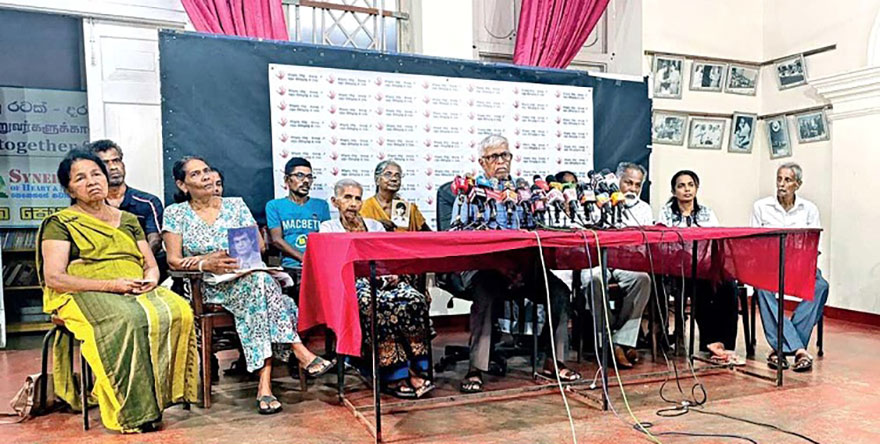
Few foresaw skeletons of Batalanda come crashing down in a London television interview. There have been plenty of speculations about the intended purposes and commentaries on the unintended outcomes of Ranil Wickremesinghe’s Al Jazeera interview. The more prurient takes on the interview have been about the public dressing down of the former president by the pugnacious interviewer Mehdi Hasan. Only one person seems convinced that Mr. Wickremesinghe had the better of the exchanges. That person is Ranil Wickremesinghe himself. That is also because he listens only to himself, and he keeps himself surrounded by sidekicks who only listen and serve. But there is more to the outcome of the interview than the ignominy that befell Ranil Wickremesinghe.
Political commentaries have alluded to hidden hands and agendas apparently looking to reset the allegations of war crimes and human rights violations so as to engage the new NPP government in ways that would differentiate it from its predecessors and facilitate a more positive and conclusive government response than there has been so far. Between the ‘end of the war’ in 2009, and the election of President Anura Kumara Dissanayake and the NPP government in 2024, there have been four presidents – Mahinda Rajapaksa, Maithripala Sirisena, Gotabaya Rajapaksa and Ranil Wickremesinghe – and as many governments. Of the four, Ranil Wickremesinghe is the least associated with the final stages of the war and its ending. In fact, he was most associated with a failed, even flawed peace process that ultimately ensured the resumption of the war with vengeance on both sides. RW was also the most receptive to war crimes investigations even proffering that external oversight would not be a violation of Sri Lanka’s Constitution.
One school of thought about the Al Jazeera interview is that those who arranged it were hoping for Ranil Wickremesinghe to reboot the now stalling war crimes project and bring pressure on the NPP government to show renewed commitment to it. From the looks of it, the arrangers gave no thought to Ranil Wickremesinghe’s twin vulnerabilities – on the old Batalanda skeletons and the more recent Easter Sunday bombings. If Easter Sunday was a case of criminal negligence, Batalanda is the site of criminal culpability. In the end, rather than rebooting the Geneva project, the interview resurrected the Batalanda crimes and its memories.
The aftermath commentaries have ranged between warning the NPP government that revisiting Batalanda might implicate the government for the JVP’s acts of violence at that time, on the one hand, and the futility of trying to hold anyone from the then government accountable for the torture atrocities that went on in Batalanda, including Ranil Wickremesinghe. What is missing and overlooked in all this is the cry of the victims of Batalanda and their surviving families who have been carrying the burden of their memories for 37 years, and carrying as well, for the last 25 years, the unfulfilled promises of the Commission that inquired into and reported on Batalanda.
The families impacted by Batalanda gave a moving illustration of the agony they have been going through for all these years in a recent media briefing, in Colombo, organized by the indefatigable human rights activist Brito Fernando. I am going by the extensive feature coverage of the media event and the background to Batalanda written by Kamanthi Wickremesinghe in the Daily Mirror (March 20, 2025). I am also borrowing her graphics for illustration – a photograph of the media briefing and a map of Sri Lanka showing the scattered sites of mass graves – 20 in all.
“We express gratitude to this government for providing the environment to discuss and debate about the contents of this report,” said Brito Fernando, speaking for the families. After addressing Ranil Wickremesinghe’s obfuscations about his involvement, and decrying Chandrika Kumaratunga’s failure to act on the recommendations of the report of the Batalanda Commission of Inquiry she created, Mr. Fernando appealed to the present NPP government to “provide a secure environment where these victims could come out and speak about their experiences,” Nothing more, nothing less, and that is all there is to it.
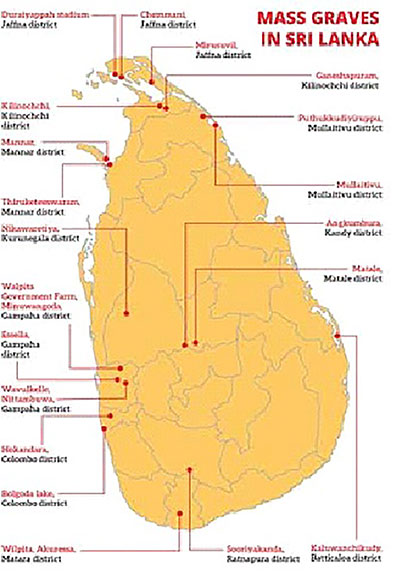 Whatever anyone else might say, the victims of Batalanda and their survivors have vindicated the NPP government’s decision to formally table the Batalanda Commission Report in parliament. As for their continuing expectations, Brito Fernando went on say, “We have some hopes regarding this government, but they should walk the talk.” Mr. Fernando suggested that the government should co-ordinate with the UNHRC’s Sri Lanka Accountability Project that has become a valuable resource for preserving evidence and documentation involving human rights crimes and violations over many decades. In addition, Mr. Fernando pointed out that the grieving families have not been involved in the ongoing excavations of mass graves, and they are anxious to receive the remains of their dear ones after their identity is confirmed through DNA analyses. Nor has there been any sign of legal action being taken against any of the suspects connected to the mass graves.
Whatever anyone else might say, the victims of Batalanda and their survivors have vindicated the NPP government’s decision to formally table the Batalanda Commission Report in parliament. As for their continuing expectations, Brito Fernando went on say, “We have some hopes regarding this government, but they should walk the talk.” Mr. Fernando suggested that the government should co-ordinate with the UNHRC’s Sri Lanka Accountability Project that has become a valuable resource for preserving evidence and documentation involving human rights crimes and violations over many decades. In addition, Mr. Fernando pointed out that the grieving families have not been involved in the ongoing excavations of mass graves, and they are anxious to receive the remains of their dear ones after their identity is confirmed through DNA analyses. Nor has there been any sign of legal action being taken against any of the suspects connected to the mass graves.
The map included here shows twenty identified mass graves spread among six of the country’s nine provinces. There could be more of them. They are a constant reminder of the ravages that the country suffered through over five decades. They are also a permanent source of pain to those whose missing family members became involuntary tenants in one or another mass grave. The families and communities around these mass graves deserve the same opportunity that the impacted families of Batalanda have been given by the current exposure of the Batalanda Commission Report.
The primary purpose of dealing with past atrocities and the mass graves that hold their victims is to give redress to survivors of victims, tend to their long lasting scars and reengage them as free and full members of the community. Excavation and Recovery, DNA Analysis and Community Engagement have become the three pillars of the recuperation process. Sri Lanka is among nearly a hundred countries that are haunted by mass graves. Many of them have far greater numbers of mass graves assembled over even longer periods. Suffering and memories are not quantitative; but unquantifiable and ineluctable emotions. The UN counts three buried victims as a mass grave. Even a single mass grave is one too many.
To do nothing about them is a moral and social copout at every level of society and in the organization of its state. Normalising the presence of mass graves is never an option for those who live around them and have their family members buried in them. Not for them who have built up over centuries, emotional systems of rituals for parting with their beloved ones. And it should not be so for governments that would otherwise go digging anywhere and everywhere in pseudo-archaeological pursuits.
Mass graves are created because of government actions and actions against governments. But governments come and go, and people in governments and political organizations change from time to time. There is a new government in town with a new generation of members in the Sri Lankan parliament, and it is time that this government revisited the country’s past and started providing even some redress to those who have suffered the most. The families of the Batalanda victims have vindicated the NPP government’s action to officially publicise the Batalanda Commission Report. The government must move on in that direction ignoring the carping of critics who selectively remember only the old JVP’s past.
There is more to what the government can do beyond mass graves. The Batalanda Commission Report is one of reportedly 36 such reports and each Commission has provided its fact findings and recommendations. Hardly any of them have been acted upon – not by the governments that appointed them and not by the governments that came after and created their own commissions. The JVP government must seriously consider creating a one last Commission, a Summary Commission, so to speak, to pull together all the findings and recommendations of previous commissions and identify steps and measures that could be integrated into ongoing initiatives and programs of the government.
The cynical alternative is to throw up one’s hands and do nothing, similar to cynically leaving the mass graves alone and doing nothing about them. The more sinister alternative was what Gotabaya Rajapaksa attempted when he appointed a new Commission of Inquiry to “assess the findings and recommendations” of previous commissions. That attempt was roundly condemned as a witch hunt against political opponents set up under the 1978 Commissions of Inquiry Act that was specifically enacted to enable the targeting political opponents under the guise of an inquiry. Repealing that act should be another consideration for the NPP government.
I am just floating the idea of a Summary Commission as a potential framework to bring positive closure to all the war crimes, emblematic crimes and human rights violations that have been plaguing Sri Lanka for the entire first quarter of this century. It is a political idea befitting the promises of a still new government, and one that would also be a positive fit for the government’s much touted Clean Sri Lanka initiative. For sure, it would be moral cleansing along with physical cleansing. A Summary Commission could also provide a productive forum for addressing the pathetic dysfunctions of the whole law and order system. The NPP government inherited a wholly broken down law and order system from its predecessors, but its critics suddenly see a national security crisis and it is all this government’s fault.
More substantively, a Summary Commission could tap into the resources of the UNHRC in collegial and collaborative ways without the hectoring and adversarial baggage of the past. These must be trying times for the UNHRC, as indeed for all UN agencies, given the full flight of Trumpism in America and its global spill over. Sri Lanka is one of a handful of countries where UNHRC professionals might find some headway for their mission. And the NPP government could be a far more reliable partner than any of its predecessors.
by Rajan Philips
-
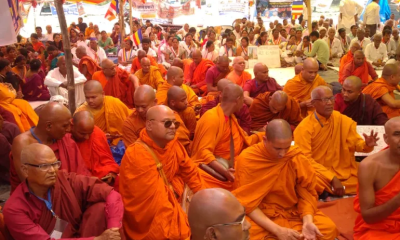
 Foreign News7 days ago
Foreign News7 days agoBuddhism’s holiest site erupts in protests over Hindu ‘control’ of shrine
-
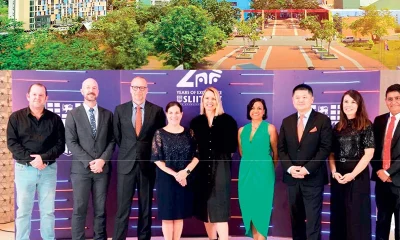
 Features5 days ago
Features5 days agoCelebrating 25 Years of Excellence: The Silver Jubilee of SLIIT – PART I
-
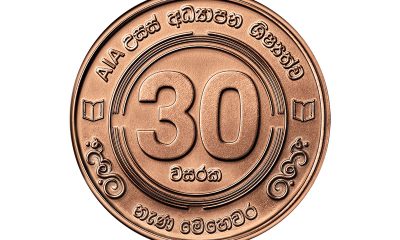
 Business3 days ago
Business3 days agoAIA Higher Education Scholarships Programme celebrating 30-year journey
-

 Business5 days ago
Business5 days agoCEB calls for proposals to develop two 50MW wind farm facilities in Mullikulam
-
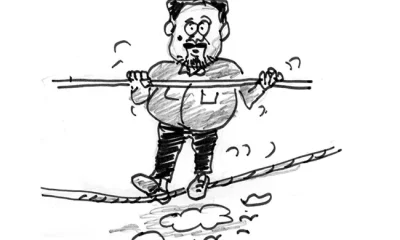
 Features5 days ago
Features5 days agoNotes from AKD’s Textbook
-
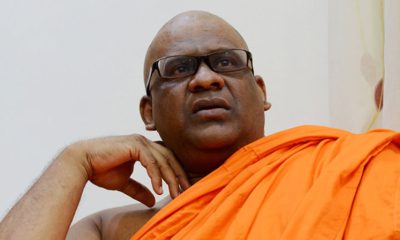
 News2 days ago
News2 days agoGnanasara Thera urged to reveal masterminds behind Easter Sunday terror attacks
-
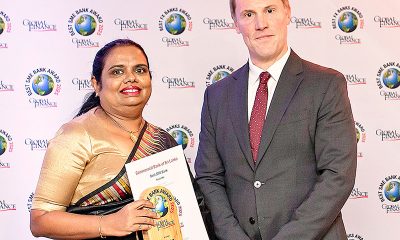
 News1 day ago
News1 day agoComBank crowned Global Finance Best SME Bank in Sri Lanka for 3rd successive year
-
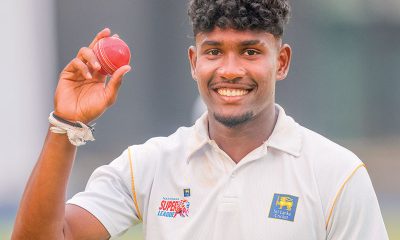
 Sports1 day ago
Sports1 day agoSri Lanka’s eternal search for the elusive all-rounder

